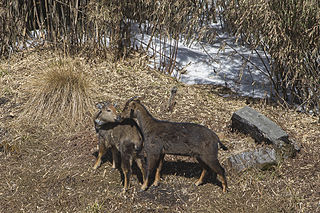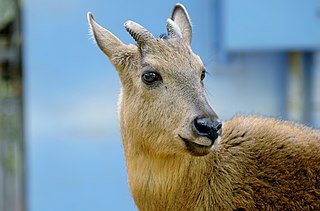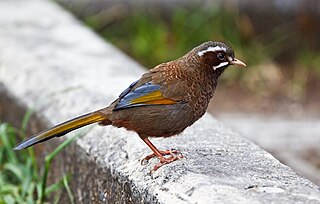
The African buffalo is a large sub-Saharan African bovine. There are five subspecies that are recognized as being valid. Syncerus caffer caffer, the Cape buffalo, is the nominotypical subspecies, and the largest one, found in Southern Africa and East Africa. S. c. nanus is the smallest subspecies, common in forest areas of Central Africa and West Africa, while S. c. brachyceros is in West Africa and S. c. aequinoctialis is in the savannas of East Africa. The adult African buffalo's horns are its characteristic feature: they have fused bases, forming a continuous bone shield across the top of the head, referred to as a "boss".

The mountain goat, also known as the Rocky Mountain goat, is a cloven-footed mammal that is endemic to the remote and rugged mountainous areas of western North America. A subalpine to truly alpine species, it is a sure-footed climber commonly seen on sheer rock faces, near-vertical cliffs and icy passages. Mountain goats generally avoid venturing down into lower elevations—except during seasonal food shortages or during particularly bad weather—as the extreme elevation which they inhabit is their primary defense against predators such as black and brown bears, pumas and wolves.

Yu Shan or Yushan, also known as Mount Jade, Jade Mountain, Tongku Saveq or Mount Niitaka during Japanese rule, is the highest mountain in Taiwan at 3,952 m (12,966 ft) above sea level, giving Taiwan the 4th-highest maximum elevation of any island in the world. It is the highest point in the western Pacific region outside of the Kamchatka Peninsula. Yushan and its surrounding mountains belong to the Yushan Range. The area was once in the ocean; it rose to its current height because of the Eurasian Plate's movement over the Philippine Sea Plate. Yushan is ranked 40th by topographic isolation.

The four-horned antelope, also called chousingha, is a small bovid antelope native to central, South and Western India, along with a smaller population in Nepal. The sole member of the genus Tetracerus, the chousingha was first described in 1816 by French zoologist Henri Marie Ducrotay de Blainville. Three regional subspecies are currently recognised. The four-horned antelope has a yellowish-tan, sometimes reddish or goldenrod coat. It is slender with thin legs and a short tail. It stands nearly 55–64 cm (22–25 in) at the shoulder and weighs about 17–22 kg (37–49 lb). Its four horns are unique among antelopes and distinguish it from most other bovids. The longer pair of straight, spike-like horns is atop its head between the ears, while the other, shorter pair is on the forehead; its posterior horns are always longer than the anterior horns, which may even present as merely fur-covered "studs". While the posterior horns measure 8–12 cm (3.1–4.7 in), the anterior ones are usually 2–5 cm (0.79–1.97 in) long.

The Formosan black bear, also known as the Taiwanese black bear or white-throated bear, is a subspecies of the Asiatic black bear. It was first described by Robert Swinhoe in 1864. Formosan black bears are endemic to Taiwan. They are also the largest land animals and the only native bears (Ursidae) in Taiwan. They are seen to represent the Taiwanese nation.

The Mikado pheasant is a species of gamebird in the pheasant family Phasianidae of the order Galliformes, gallinaceous birds. Sometimes considered an unofficial national bird of Taiwan, a pair of Mikado pheasants and Yushan National Park, one of the areas it is known to inhabit, is depicted in the 1000 dollar bill of the New Taiwan dollar.

The Formosan clouded leopard is a clouded leopard population that was endemic to Taiwan. Camera trapping studies carried out in several protected areas in Taiwan between 1997 and 2012 did not record any clouded leopard. The population is listed as extinct on the IUCN Red List.

The Japanese serow is a Japanese goat-antelope, an even-toed ungulate. It is found in dense woodland in Japan, primarily in northern and central Honshu. The serow is seen as a national symbol of Japan, and is subject to protection in conservation areas.

Yushan National Park is one of the nine national parks in Taiwan and was named after the summit Yushan, the highest peak of the park. The park covers a total area of 103,121 hectares that includes large sections of the Central Mountain Range. The park contains more than thirty peaks over 3,000 metres (9,843 ft) in elevation, and two-thirds of the area within the park is above 2,000 metres (6,562 ft). The elevation difference in the park is 3,600 metres (11,811 ft), and there are many canyons, cliffs, and valleys.

The gemsbok, or South African oryx, is a large antelope in the genus Oryx. It is endemic to the dry and barren regions of Botswana, Namibia, South Africa and Zimbabwe, mainly inhabiting the Kalahari and Namib Deserts, areas in which it is supremely adapted for survival. Previously, some sources classified the related East African oryx, or beisa oryx, as a subspecies.

The Himalayan goral or the gray goral, is a bovid species native to the Himalayas. It is listed as Near Threatened on the IUCN Red List because the population is thought to be declining significantly due to habitat loss and hunting for meat.

Mount Sanqing is a renowned Taoist sacred mountain located 40 kilometres (25 mi) north of Yushan County in Jiangxi Province. Sanqing means the "Three Pure Ones" in Chinese as Mount Sanqing is made up of three main summits: Yujing, Yushui, and Yuhua, representing the Taoist trinity.

The mainland serow is a species of serow native to the Himalayas, Southeast Asia and China.

The red goral is a species of even-toed ungulate in the subfamily Caprinae in the family Bovidae. It is found in India, Tibet and Myanmar. Its natural habitats are seasonal mountainous areas 1,000 to 2,000 meters above sea level. It is threatened by habitat loss and hunting.

The white-whiskered laughingthrush or Formosan laughing thrush is a species of bird in the family Leiothrichidae. It is endemic to montane forests of the island of Taiwan.

The Taiwan whistling thrush, also known as the Formosan whistling thrush, is a species of bird in the family Muscicapidae. It is endemic to Taiwan.

Oncorhynchus masou formosanus, commonly known as the Formosan salmon, Taiwanese trout, Tsugitaka trout, Lishan trout or Slamaw trout, is an endangered freshwater fish endemic to the mountain stream valleys between the Xueshan and Central Ranges of Taiwan. It is the southernmost subspecies of masu salmon, and one of the most temperately distributed salmonids along with the Mexican golden trout and Mexican rainbow trout.

The serow, is any of four species of medium-sized goat-like or antelope-like mammals in the genus Capricornis. All four species of serow were, until recently, classified under Naemorhedus, which now only contains the gorals.

The Himalayan serow, also known as the thar, is a subspecies of the mainland serow native to the Himalayas. It was previously considered its own species, as Capricornis thar. It is the official state animal of the Indian state of Mizoram.




















